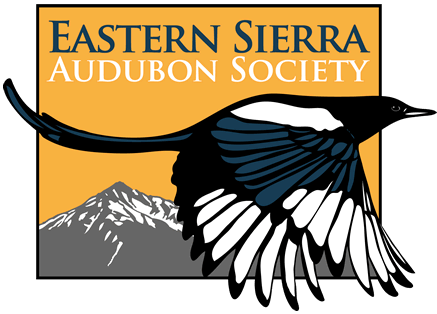The hottest birding spot in Inyo County in August is Death Valley! The hottest birding spot in Inyo County in May is… Death Valley! Obviously two different ways of describing hot. We will reveal the birding spots that consistently turn up “hot” birds, that is, the unexpected and unusual and at the same time entertain you with the expected. Each area is better at different seasons so choose the season and/or birds you are interested in and match with the best location.
BIRCHIM CANYON, located about 10 miles north of Bishop, has been put on the birding map by Jim & Debby Parker who first discovered its wonders. Park at the pulloff on Hwy 395 and walk down the dirt trail surrounded by prime riparian vegetation to the Pleasant Valley Dam power station. This area provides nesting habitat for threatened Yellow-breasted Chats and resting spots for unexpected Northern Parula and Blackburnian Warblers. You’ll hear the raspy song of Belted Kingfishers and the tumbling delight of Canyon Wrens. Other similiar locations are BAKER CREEK, discovered by Earl Gann, and the recently burned CAMP INYO area, both just west of Big Pine. These areas also provide nesting habitats for the endangered Yellow-billed Cuckoo, threatened chat and Summer Tanager. Rarities, in spring and fall, are Worm-eating Warbler and Red-eyed Vireo. Anywhere along the OWENS RIVER provides the same exciting habitat but is more difficult to bird because of its extensiveness.
Because Inyo County is largely desert the watered sites provide critically important resting and feeding areas for a wide variety of birds. PLEASANT VALLEY RESERVOIR deserves a walk or bike ride from spring to fall when you can see loons, grebes and ducks in the water, wrens and sparrows on the canyon sides, and warblers in the willows. KLONDIKE AND WARREN LAKES, northeast and northwest, respectively, of Big Pine are worth checking regularly. The marsh at the north end of Klondike hides the nests of American Bittern, Red-winged & Yellow-headed Blackbirds. The tules along the sides contain chattering Marsh Wrens and Common Yellowthroats singing “whitchity, whitchity”. Tundra Swans are regular here in winter. Ibis, egrets, herons and rails rest and feed during migration. TINEMAHA RESERVOIR can be birded from the overlook where you can see loons and pelicans (spring and fall), ducks, geese, swans and vagrant gulls (winter), or from the north and east side where you can get up close and personal views of myriad shorebirds (April to May & July to October). BILLY LAKE, east of Independence, has the only colony of nesting Least Bitterns and the swampy area at the north turned up a golden Prothonotary Warbler. The best shorebird area in the county is COTTONWOOD MARSH on the west side of Owens Lake. Because of quality bird sightings, birders from all over the country stop here to see what they can find. This area is also attractive to hunters because of the use by ducks and geese. The plan to mine soda ash, approved by the supervisors, requires pumping ground water which could be devastating to this unique marsh if the springs dry up as they have done throughout the valley. While at Owens Lake visit DIRTY SOCKS at the south end and the areas north and south of KEELER. Marshes are the least common habitat in the county and both have small but special ones that usually allow good views of rails and shorebirds and if you are lucky you might find the second county record of a Long-tailed Jaeger. WARM SPRINGS, southeast of Bishop, is another excellent marshy area where Northern Harriers regularly breed. Other proven hot spots are GRlMSHAW LAKE near Tecopa, FURNACE CREEK RANCH, the salt marsh at SALINE VALLEY, FARMER’S POND, (northeast of Bishop), HAIWEE RESERVOIR and SEWER PONDS anywhere. Water level is the crucial factor in attracting shorebirds. Too high or too low and the birds won’t be able to feed.
For excellent coniferous forest birding you have only to follow any of the roads that climb the Sierra. Some of the best can be found around NORTH & SOUTH LAKE, west of Bishop, GLACIER LODGE, west of Big Pine, ONION VALLEY, west of Independence, WHITNEY PORTAL and HORSESHOE MEADOW, west and southwest of Lone Pine. If visiting during the summer you will see the resident birds busy nesting; if you visit during the spring or fall you will also see some birds using the Sierra as a migratory route. GRANDVIEW CAMPGROUND and SCHULMAN GROVE in the White Mountains dish up Red Crossbill, Gray Flycatcher and Golden Eagle. WHIP-POOR-WILL FLAT in the Inyo Mountains and MAHOGANY FLAT in the Panamints provide the best in pinon-juniper birding with Plain Titmouse and Pinon Jay calling a welcome.
If RAPTORS are your interest you are in luck. Best time for variety and numbers is winter; best place is near alfalfa fields which provide the rodents. Each town in the Owens Valley has its fields. Wintertime sees the return of northern breeders like Ferruginous and Rough-legged Hawks, Prairie Falcon, and Merlin. Summertime sees the return from Argentina, of the Swainson’s Hawk, whose bulky stick nests are easily seen near many ranches. This hawk is slowly declining throughout its range but seems to be hanging on here. Also obvious in summer are the resident Red-tailed Hawk and American Kestrel, the smallest North American falcon.
Good birds can be found just about anywhere in the county. One of the most enjoyable aspects of birding is to find your own favorite spot and keep track of what you see there. Over the years this information becomes data upon which you can help others determine if the species is doing well or not. This special spot can be your yard, a nearby park, a spot along the river or a mountain peak. Find such a place and enjoy!
Tags: blackbird, duck, egret, falcon, flycatcher, grebe, gulls, hawk, heron, kestrel, loon, owl, pelican, sparrow, swan, vireo, warbler, wren
